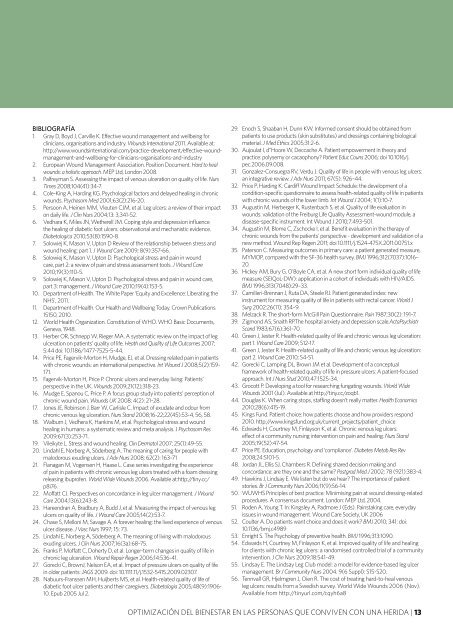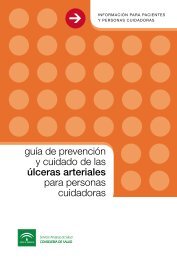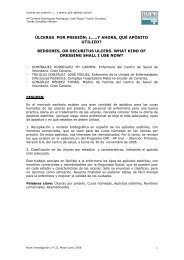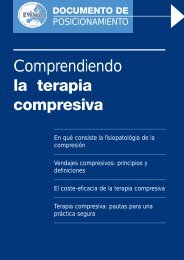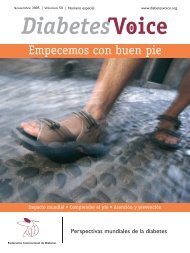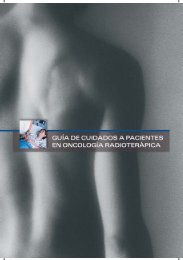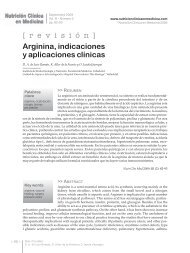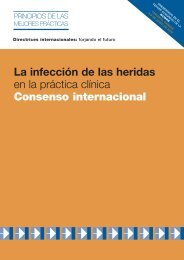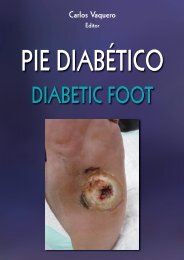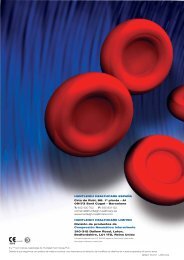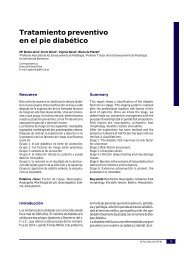OPTIMIZACIÓN DEL BIENESTAR - Wounds International
OPTIMIZACIÓN DEL BIENESTAR - Wounds International
OPTIMIZACIÓN DEL BIENESTAR - Wounds International
You also want an ePaper? Increase the reach of your titles
YUMPU automatically turns print PDFs into web optimized ePapers that Google loves.
BIBLIOGRAFÍA1. Gray D, Boyd J, Carville K. Effective wound management and wellbeing forclinicians, organisations and industry. <strong>Wounds</strong> <strong>International</strong> 2011. Available at:http://www.woundsinternational.com/practice-development/effective-woundmanagement-and-wellbeing-for-clinicians-organisations-and-industry2. European Wound Management Association. Position Document. Hard to healwounds: a holistic approach. MEP Ltd, London 2008.3. Palfreyman S. Assessing the impact of venous ulceration on quality of life. NursTimes 2008;104(41):34-7.4. Cole-King A, Harding KG. Psychological factors and delayed healing in chronicwounds. Psychosom Med 2001;63(2):216-20.5. Persoon A, Heinen MM, Vleuten CJM, et al. Leg ulcers: a review of their impacton daily life. J Clin Nurs 2004;13: 3,341-52.6. Vedhara K, Miles JN, Wetherell JM. Coping style and depression influencethe healing of diabetic foot ulcers: observational and mechanistic evidence.Diabetologica 2010;53(8):1590-8.7. Solowiej K, Mason V, Upton D Review of the relationship between stress andwound healing: part 1. J Wound Care 2009; 8(9):357-66.8. Solowiej K, Mason V, Upton D. Psychological stress and pain in woundcare, part 2: a review of pain and stress assessment tools. J Wound Care2010;19(3):110-5.9. Solowiej K, Mason V, Upton D. Psychological stress and pain in wound care,part 3: management. J Wound Care 2010;19(4):153-5.10. Department of Health. The White Paper ‘Equity and Excellence: Liberating theNHS’, 2011.11. Department of Health. Our Health and Wellbeing Today. Crown Publications15150, 2010.12. World Health Organization. Constitution of WHO. WHO Basic Documents,Geneva, 1948.13. Herber OR, Schnepp W, Rieger MA. A systematic review on the impact of legulceration on patients’ quality of life. Heath and Quality of Life Outcomes 2007;5:44 doi: 10.1186/1477-7525-5-44.14. Price PE, Fagervik-Morton H, Mudge, EJ, et al. Dressing related pain in patientswith chronic wounds: an international perspective. Int Wound J 2008;5(2):159-171.15. Fagervik-Morton H, Price P. Chronic ulcers and everyday living: Patients’perspective in the UK. <strong>Wounds</strong> 2009;21(12);318-23.16. Mudge E, Spanou C, Price P. A focus group study into patients’ perception ofchronic wound pain. <strong>Wounds</strong> UK 2008; 4(2): 21–28.17. Jones JE, Robinson J, Barr W, Carlisle C. Impact of exudate and odour fromchronic venous leg ulceration. Nurs Stand 2008;16-22;22(45):53-4, 56, 58.18. Walburn J, Vedhera K, Hankins M, et al. Psychological stress and woundhealing in humans: a systematic review and meta analysis. J Psychosom Res2009;67(3):253-71.19. Vileikyte L. Stress and wound healing. Clin Dermatol 2007; 25(1):49-55.20. Lindahl E, Norberg A, Söderberg A. The meaning of caring for people withmalodorous exuding ulcers. J Adv Nurs 2008; 62(2): 163–7121. Flanagan M, Vogensen H, Haase L. Case series investigating the experienceof pain in patients with chronic venous leg ulcers treated with a foam dressingreleasing ibuprofen. World Wide <strong>Wounds</strong> 2006. Available at:http://tiny.cc/p8i76.22. Moffatt CJ. Perspectives on concordance in leg ulcer management. J WoundCare 2004;13(6):243-8.23. Hareendran A, Bradbury A, Budd J, et al. Measuring the impact of venous legulcers on quality of life. J Wound Care 2005;14(2):53-7.24. Chase S, Melloni M, Savage A. A forever healing: the lived experience of venousulcer disease. J Vasc Nurs 1997; 15: 73.25. Lindahl E, Norberg A, Söderberg A. The meaning of living with malodorousexuding ulcers. J Clin Nurs 2007;16(3a):68–75.26. Franks P, Moffatt C, Doherty D, et al. Longer-term changes in quality of life inchronic leg ulceration. Wound Repair Regen 2006;14:536-41.27. Gorecki C, BrownJ, Nelson EA, et al. Impact of pressure ulcers on quality of lifein older patients: JAGS 2009. doi: 10.1111.11/j.1532-5415.2009.02307.28. Nabuurs-Franssen MH, Huijberts MS, et al. Health-related quality of life ofdiabetic foot ulcer patients and their caregivers. Diabetologia 2005;48(9):1906-10. Epub 2005 Jul 2.29. Enoch S, Shaaban H, Dunn KW. Informed consent should be obtained frompatients to use products (skin substitutes) and dressings containing biologicalmaterial. J Med Ethics 2005;31:2-6.30. Aujoulat I, d"Hoore W, Deccache A. Patient empowerment in theory andpractice: polysemy or cacaophony? Patient Educ Couns 2006; doi 10.1016/j.pec.2006.09.008.31. Gonzalez-Consuegra RV, Verdu J. Quality of life in people with venous leg ulcers:an integrative review. J Adv Nurs 2011; 67(5): 926–44.32. Price P, Harding K. Cardiff Wound Impact Schedule: the development of acondition-specific questionnaire to assess health-related quality of life in patientswith chronic wounds of the lower limb. Int Wound J 2004; 1(1):10-7.33. Augustin M, Herberger K, Rustenbach S, et al. Quality of life evaluation inwounds: validation of the Freiburg Life Quality Assessment-wound module, adisease-specific instrument. Int Wound J 2010;7:493-501.34. Augustin M, Blome C, Zschocke I, et al. Benefit evaluation in the therapy ofchronic wounds from the patients' perspective - development and validation of anew method. Wound Rep Regen 2011; doi 10.1111/j.1524-475X.2011.00751.x35. Paterson C. Measuring outcomes in primary care: a patient generated measure,MYMOP, compared with the SF-36 health survey. BMJ 1996;312(7037):1016–20.36. Hickey AM, Bury G, O'Boyle CA, et al. A new short form individual quality of lifemeasure (SEIQoL-DW): application in a cohort of individuals with HIV/AIDS.BMJ 1996;313(7048):29–33.37. Camilleri-Brennan J, Ruta DA, Steele RJ. Patient generated index: newinstrument for measuring quality of life in patients with rectal cancer. World JSurg 2002:26(11); 354–9.38. Melzack R. The short-form McGill Pain Questionnaire. Pain 1987;30(2): 191–7.39. Zigmond AS, Snaith RP.The hospital anxiety and depression scale.ActaPsychiatrScand 1983;67(6):361–70.40. Green J, Jester R. Health-related quality of life and chronic venous leg ulceration:part 1. Wound Care 2009; S12-17.41. Green J, Jester R. Health-related quality of life and chronic venous leg ulceration:part 2. Wound Care 2010; S4-S1.42. Gorecki C, Lamping DL, Brown JM et al. Development of a conceptualframework of health-related quality of life in pressure ulcers: A patient-focusedapproach. Int J Nurs Stud 2010;47:1525-34.43. Grocott P. Developing a tool for researching fungating wounds. World Wide<strong>Wounds</strong> 2001 (Jul). Available at http://tiny.cc/zoqb1.44. Douglas K. When caring stops, staffing doesn’t really matter. Health Economics2010;28(6):415-19.45. Kings Fund. Patient choice: how patients choose and how providers respond2010. http://www.kingsfund.org.uk/current_projects/patient_choice46. Edwards H, Courtney M, Finlayson K, et al. Chronic venous leg ulcers:effect of a community nursing intervention on pain and healing. Nurs Stand2005;19(52):47-54.47. Price PE. Education, psychology and ‘compliance’. Diabetes Metab Res Rev2008;24:S101-5.48. Jordan JL, Ellis SJ, Chambers R. Defining shared decision making andconcordance: are they one and the same? Postgrad Med J 2002; 78 (921):383-4.49. Hawkins J, Lindsay E. We listen but do we hear? The importance of patientstories. Br J Community Nurs 2006;11(9):S6-14.50. WUWHS Principles of best practice: Minimising pain at wound dressing-relatedprocedures. A consensus document. London: MEP Ltd, 2004.51. Roden A, Young T. In: Kingsley A, Padmore J (Eds). Painstaking care, everydayissues in wound management. Wound Care Society, UK 200652. Coulter A. Do patients want choice and does it work? BMJ 2010; 341: doi:10.1136/bmj.c498953. Enright S. The Psychology of preventive health. BMJ 1996;313:1090.54. Edwards H, Courtney M, Finlayson K, et al. Improved quality of life and healingfor clients with chronic leg ulcers: a randomised controlled trial of a communityintervention. J Clin Nurs 2009;18:541-49.55. Lindsay E. The Lindsay Leg Club model: a model for evidence-based leg ulcermanagement. Br J Community Nurs 2004. 9(6 Suppl): S15-S20.56. Tennvall GR, Hjelmgren J, Oien R. The cost of treating hard-to-heal venousleg ulcers: results from a Swedish survey. World Wide <strong>Wounds</strong> 2006 (Nov).Available from http://tinyurl.com/cqyh6a8<strong>OPTIMIZACIÓN</strong> <strong>DEL</strong> <strong>BIENESTAR</strong> EN LAS PERSONAS QUE CONVIVEN CON UNA HERIDA | 13


